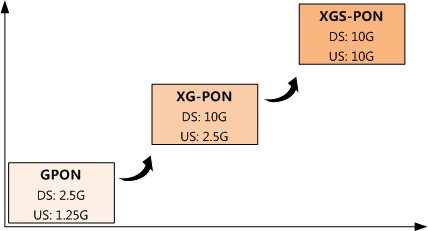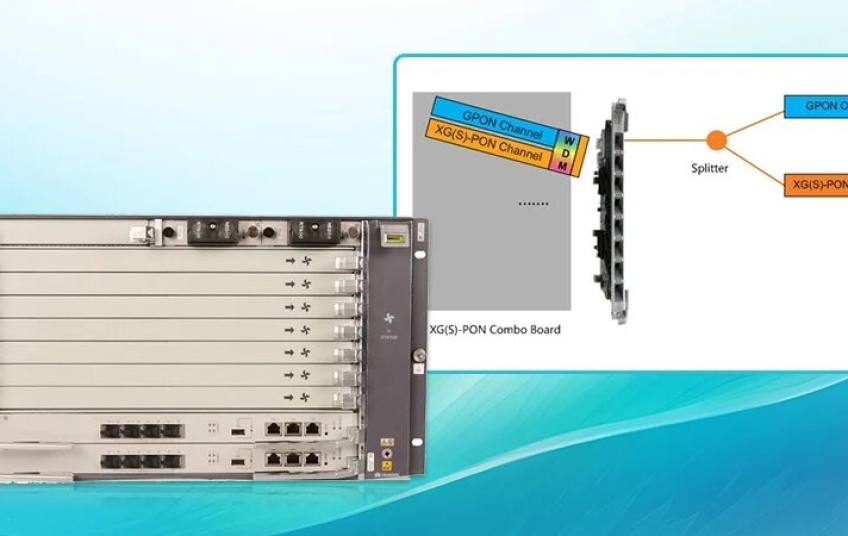As the development of PON technology and user’s higher bandwidth requirement, more and more service providers start to deploy 10G GPON. As we know, 10G GPON has asymmetrical XGPON and symmetrical XGSPON, you may wonder which one should be chosen when we consider migratation from GPON to 10G-PON?

Choosing between XGPON and XGSPON for upgrading your network infrastructure depends on several factors including bandwidth requirements, future scalability, cost, and application use cases, etc. This blog will help you decide which upgrade path might be more suitable for your needs:
Specification |
XG-PON |
XGS-PON |
Wavelength |
Downstream: 1575-1580 nm |
Downstream: 1575-1580 nm |
Upstream: 1260-1280 nm |
Upstream: 1260-1280 nm |
|
Center wavelength |
Downstream: 1577 nm |
Downstream: 1577 nm |
Upstream: 1270 nm |
Upstream: 1270 nm |
|
Maximum Line Rate |
Downstream: 9.953 Gbit/s |
Downstream: 9.953 Gbit/s |
Upstream: 2.488 Gbit/s |
Upstream: 9.953 Gbit/s |
|
Frame Structure |
XGEM |
XGEM |
XGPON (Asymmetrical)
Overview:
-
Standard: ITU-T G.987
-
Downstream Rate: 10 Gbps
-
Upstream Rate: 2.5 Gbps
-
Symmetry: Asymmetrical
Advantages:
-
High Downstream Capacity: The 10 Gbps downstream rate makes it suitable for applications with heavy download requirements, such as video streaming and content delivery.
-
Cost-Effective: For instance, Huawei OLT MA5800 XG-PON Combo Service Card such as CGHF can be 3-4 times cheaper than XGS-PON Combo Service Card CSHF because of the lower upstream rate. Thus CGHS is more cost-saving and practical upgrade solution chosen by major ISPs. In this case, user's package will be more affordable for many residential and typical business applications.
Disadvantages:
-
Limited Upstream Bandwidth: This can be a disadvantage for applications requiring substantial upstream data transfer, such as cloud backups, video conferencing, and other interactive services.
-
Future Scalability: With increasing demand for symmetrical bandwidth, XG-PON may face limitations in addressing future needs.
-
Competitive Disadvantage: As technology evolves, competitors offering symmetrical solutions may have an edge in the market, potentially making asymmetrical XG-PON less attractive to new customers.
Use Cases:
-
Residential Broadband: Ideal for residential areas where download speed is prioritized over upload speed.
-
Small and Medium Enterprises (SMEs): Suitable for SMEs with moderate upstream requirements.
XGS-PON (Symmetrical)
Overview:
-
Standard: ITU-T G.9807.1
-
Downstream Rate: 10 Gbps
-
Upstream Rate: 10 Gbps
-
Symmetry: Symmetrical
Advantages:
-
High Bandwidth: XGSPON supports up to 10 Gbps downstream and 10 Gbps upstream, making it suitable for high-demand applications and future-proofing your network.
-
Scalability: With significantly higher bandwidth, XGSPON can support more users and more data-intensive applications without degradation in performance.
-
Advanced Services: Ideal for applications requiring high data rates and low latency such as advanced video services, cloud computing, and next-gen IoT.
Disadvantages:
-
Higher Initial Cost: The initial investment for XGSPON infrastructure is higher compared to XGPON for example XGSPON OLT service card price is 3-4 times higher than XGPON service card. This includes costs for new hardware, installation, and potentially higher maintenance costs.
-
Complexity: Upgrading to XGSPON may require more complex network management and configuration.
-
Technical Expertise: Deploying and managing XGS-PON networks requires a higher level of technical expertise compared to GPON or XG-PON. Service providers may need to invest in training their technical staff or hiring specialists.
-
Market Demand and ROI: In areas where the demand for symmetrical high-speed internet is not yet high, the return on investment (ROI) for upgrading to XGS-PON may not be immediately realized. Service providers need to carefully evaluate market demand and customer readiness.
Use Cases:
-
Enterprise Services: Suitable for large businesses and enterprises that require high-speed symmetrical connections for operations like data backups, cloud services, and virtual desktops.
-
High-Density Environments: Beneficial in high-density residential or commercial areas where both downstream and upstream traffic are significant.
-
Next-Generation Applications: Supports emerging technologies and applications that require low latency and high bandwidth in both directions.
In conclusion, to choose XG-PON if your focus is primarily on high downstream capacity with moderate upstream requirements, and you aim to keep initial costs lower while still upgrading from GPON.
To choose XGS-PON if you need high bandwidth in both directions, are preparing for future applications and services that demand symmetrical speeds, and are willing to invest more upfront for a more robust and scalable network infrastructure.
Finally, the choice between XG-PON and XGS-PON depends on your specific bandwidth needs, investment cost, and the types of applications you plan to support.





